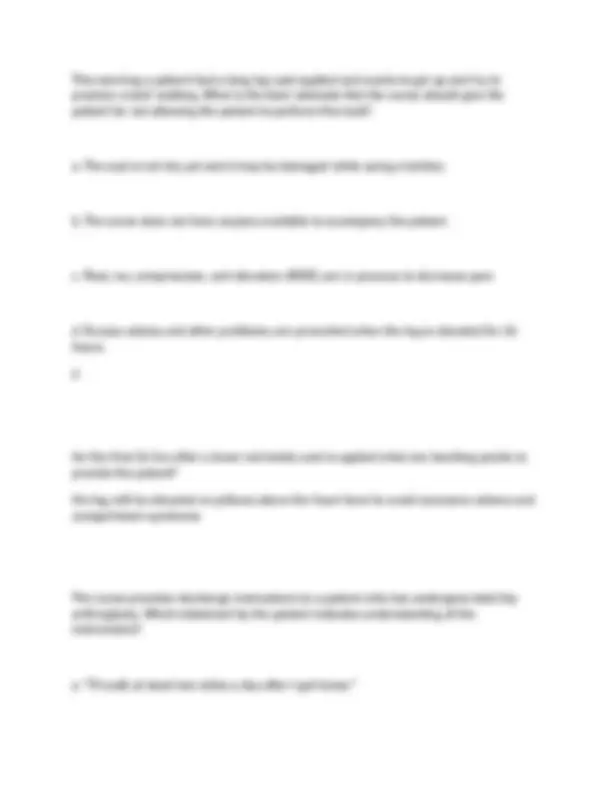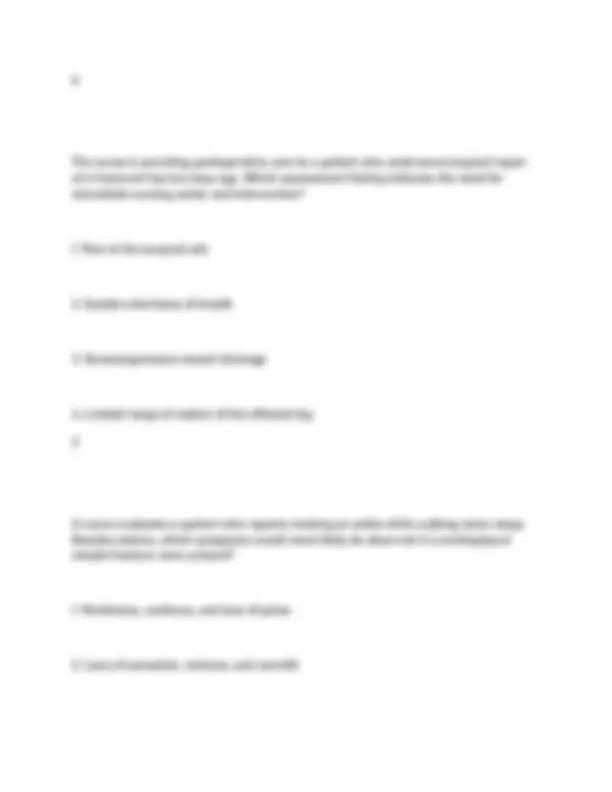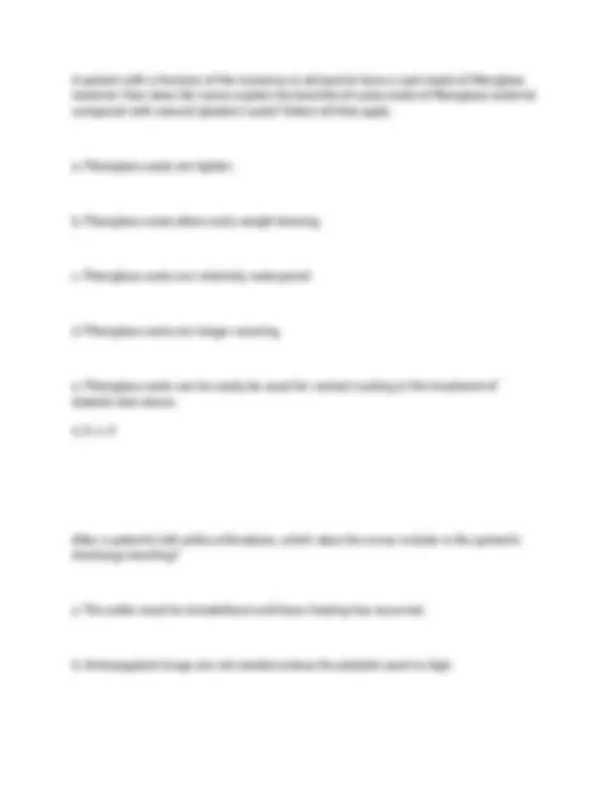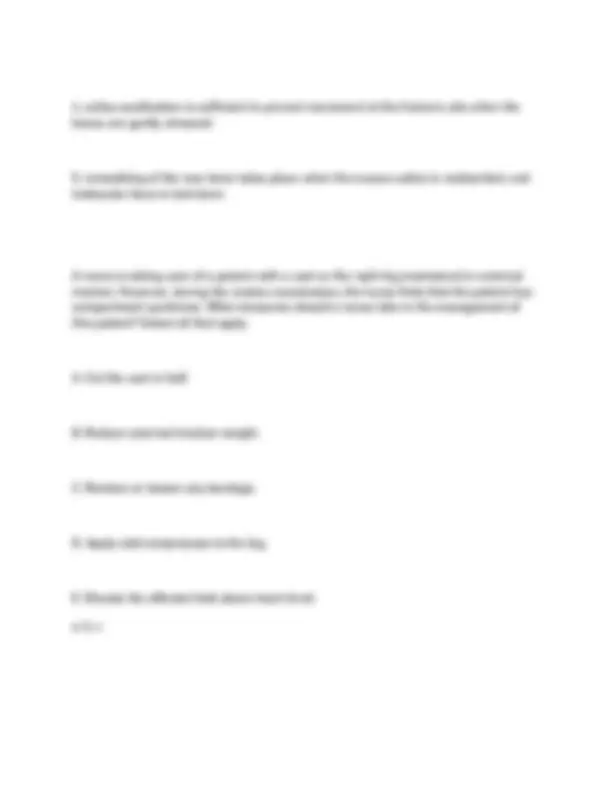






























































































Study with the several resources on Docsity

Earn points by helping other students or get them with a premium plan


Prepare for your exams
Study with the several resources on Docsity

Earn points to download
Earn points by helping other students or get them with a premium plan
Community
Ask the community for help and clear up your study doubts
Discover the best universities in your country according to Docsity users
Free resources
Download our free guides on studying techniques, anxiety management strategies, and thesis advice from Docsity tutors
NURS 6202 Final Exam 2025/2026 Questions with Correct Answers A+ Graded (Original Exam)-Marquette University
Typology: Exams
1 / 236

This page cannot be seen from the preview
Don't miss anything!





























































































A patient is hospitalized with severe bleeding in the leg. An x-ray exam of the leg reveals that the periosteum is intact across the fracture and that the bone is still in alignment. What type of fracture does the patient have? a. Oblique fracture b. Pathologic fracture c. Greenstick fracture d. Comminuted fracture c a non displacement fracture in which the periosteum is intact across the fracture and bone is still in alignment is classified as a? green stick fracture
in a ___ fracture the line of the fracture extends in an oblique direction. oblique a ___ fracture is a spontaneous fracture at the site of a bone disease. pathologic displaced fractures are usually ___ fractures in which there are more than 2 bone fragments with the smaller fragments floating or oblique. comminuted A patient with a fracture of the femur has the extremity in skeletal traction and is encouraged to use an overhead trapeze apparatus. The nurse explains that the primary purpose of the overhead trapeze is what? a. To assist with leg exercises b. To enhance breathing and lung expansion c. To promote circulation throughout the body d. To facilitate independent movement while the patient is in bed
traction is used to? immobilize a joint or part of the body to promote joint stabilization and prevent soft tissue damage promotes active and passive exercise a buck's traction boot is a? type of skin traction that is used preoperatively in a patient with a hip fracture awaiting surgery it helps to reduce muscle spasm A patient experiences a nondisplaced fracture. What condition can potentially displace the fracture in the patient? a. Crepitation b. Ecchymosis c. Muscle spasm d. Edema and swelling c
Which body part of the patient is at risk for superior mesenteric artery syndrome when sustaining a fracture? a. Knee b. Vertebrae c. Lower extremity d. Upper extremity b superior mesenteric artery syndrome occurs if? a thoracic or lumbar spine body jacket brace is applied too tightly, compressing the superior mesenteric artery against the duodenum a ___ fracture is an incomplete fracture with one side splintered and the other side bent. greenstick
d. short arm cast, providing wrist immobilization and unrestricted elbow a simple fractures and complex fractures with extensive soft tissue damage, nonunion or malunion and limb lengthening can be done through? external fixation which is often used in an attempt to salvage extremities by definition a ___ arm cast facilitates unrestricted elbow motion. short A patient experiences delayed bone healing. What function does the nurse identify as helpful by electrical bone growth stimulation? a. Increases the calcium uptake of bones b. Deactivates intracellular calcium stores c. Decreases the calcium uptake of the bone d. Decreases the production of bone growth factors a
A patient arrives in the emergency department after sustaining a fall. The initial assessment reveals that the left leg is shorter than the right and externally rotated. What condition should the nurse suspect? a. Fractured hip b. Fractured pelvis c. Fractured tibia/fibula d.Nondisplaced fractured femur a fractures require nursing assessment of? peripheral circulation (color, temperature, capillary refill, peripheral pulses, and edema) and neurologic function (sensation and motor function) postoperative care following ORIF involves applying general principles of postoperative nursing care
obvious deformity of the wrist management of colle's fracture closed reduction and immobilization by splint or cast if fracture is displaced, internal or external fixation may be used humeral fracture fractures involving the humeral shaft are a common injury among young and middle aged adults manifestations of humeral fracture obvious displacement shortened extremity pain abnormal mobility.
tx for humeral fracture depends on fracture location and displacement and may include casting, immobilization, or surgery. pelvic fractures range from relatively minor to life threatening, depending on the mechanism of injury and associated vascular damage. manifestations of pelvic fractures Physical examination may identify local swelling, tenderness, deformity, unusual pelvic movement, and ecchymosis on abdomen. tx of pelvic fractures depends on injury severity. Stables fractures are typically treated with bed rest, possibly with pelvic sling traction. Unstable fractures require external fixation and/or ORIF. ___ fractures are common in older adults hip
femoral shaft fractures are often accompanied by? soft tissue damage and considerable blood loss clinical manifestations of femoral shaft fractures include include marked deformity and angulation, pain, and the inability to move the hip or knee. initial management for femoral shaft fractures is directed toward stabilizing the patient and immobilizing the fracture most often repaired with intramedullary rod following surgery promoting and maintaining extremity strengths are important goals of care tibial fractures A great deal of force is required to produce a tibial injury. It is often complicated by infection, FES, malunion, and compartment syndrome.
tx for tibial fracture for a closed fracture of the tibia is reduction and casting complicated fractures may require rods, plates or external fixation stable vertebral fracture is one in which the bone fragments are not likely to cause spinal cord damage symptoms of stable vertebral fracture most patients experience only brief periods of disability symptoms depend on the location and extend of the fracture tx for stable vertebral fracture most pts with stable spinal fractures experience only brief periods of disability However, if spinal ligaments are significantly disrupted, dislocation of the vertebrae may occur. Instability and injury to the spinal cord may result (unstable fracture). These injuries generally require surgery.
indications for amputation include circulatory impairment for PVD traumatic or thermal injury osteomyelitis malignant tumors extremity infection the goal of amputaiton surgery is to preserve the greatest extremity length and function while removing all infected, pathologic or ischemic tissue joint surgery is aimed at? aimed at relieving pain, improving ROM, correcting deformity, and removing diseased cartilage.
arthroplasty is the reconstruction or replacement of a joint to relieve pain, improve or maintain ROM, and correct deformity. total joint arthroplasty is the most common orthopedic operation performed on older adults other types of joint surgeries include synovectomy osteotomy debridement arthrodesis is the surgical joint fusion that may be done if articular surfaces are too damaged or infected to allow joint replacement or if reconstructive surgery fails after joint surgery what should the nurse assess
Stress Impacted Compression clinical manifestations of a fracture Edema and Swelling Pain and tenderness Muscle spasm Deformity Ecchymosis/Contusion Loss of function Crepitation process of fracture healing
Hematoma formation: 2-3 days Granulation tissue (basis for new bone): 3-14 days Callus formation: 2 weeks; ossifies in 3 wks-6 mos Remodeling (callus reabsorbs): months for complete healing Gradual weight bearing over time factors that influence fracture healing age infection nutrition electrical stimulation displacement site (blood supply)